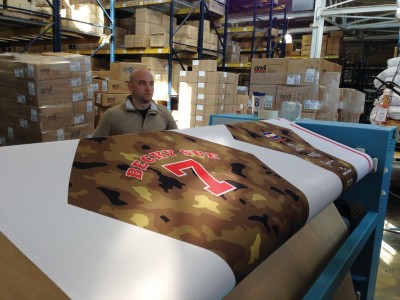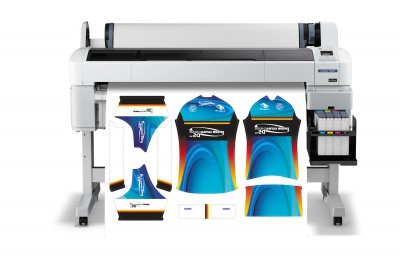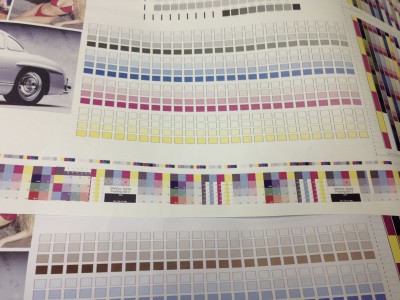Wide-format Printing: Dye sublimation goes big
by all | 31 May 2013 8:30 am
 [1]
[1]Photos courtesy Gans Ink & Supply
By Peter Saunders
The process of dye sublimation has traditionally represented a niche business opportunity with specialized applications. These days, according to a panel discussion hosted in March by the Specialty Graphic Imaging Association (SGIA), there has been a surge in adoption among mainstream sign and graphics shops.
One reason for this trend is the diversification of sign shops’ offerings into new areas, including ‘soft signage,’ interior décor and flags, along with smaller-format ‘hard’ items, like mugs, awards and keychains, which can also be dye sublimated. Another reason has been the higher quality of output when compared to the other printing processes with which signmakers are already familiar.
Surging sublimation
SGIA’s members include both garment decorators and large-format display providers. The panel discussion focused on how dye sublimation has only recently expanded from the former community to be embraced by the latter.
As such, it was a chance to provide a ‘snapshot’ of ongoing dye sublimation developments in the wide- to super-wide-format digital inkjet printing sector. Moderated by Dan Marx, SGIA’s vice-president (VP) of markets and technologies, and Jeff Burton, SGIA’s digital printing analyst, the panel included:
- Rob Eversole, director of dye sublimation for Axiom America, which distributes printers and supplies.
- Mike Wozny, product manager for Electronics for Imaging (EFI), which manufactures super-wide-format Vutek printers.
- Syd Northup, inkjet division manager for Gans Ink and Supply, which manufactures dye sublimation inks.
- Ralph Terramagra, a sales manager for Mutoh America, which develops large-format dye sublimation printers.
“We see a lot of growth in the large-format display sector with soft signage,” said Eversole, whose company has traditionally focused on customers in the garment decoration community. “We’re getting more involved in those areas, even though we’re already very busy in the cut-and-sew business.”
 [2]
[2]Dye sublimation equipment suppliers have traditionally focused on customers in the garment decoration community.
“We’ve been selling super-wide-format printers to the soft signage market for more than 10 years,” said Wozny, “but the business has increased dramatically in the last three to four years and there are big volumes of output going through those presses.”
“I’m in my 13th year working with dye sublimation inks for large-format printing,” said Northup. “The market ebbed and flowed five or six years ago, but now a lot of sign shops are coming onboard and I see it continuing to grow.”
Catching the heat
The panel participants agreed a heat transfer process, whereby the ink turns into a gas in the presence of heat and under pressure with the material, is still preferable to the seemingly simpler and increasingly common option of direct printing onto fabrics.
“With good heat transfer paper, the quality really comes through the press,” said Wozny. “You can put more ink down and it holds better, resulting in more ‘pop’ and better text quality. In high-speed printing, the material is put under significant pressure, but you can print on a wider range of materials with transfer paper. It is more difficult to print direct-to-substrate successfully, where the material tends to stretch.”
“I have a background in colour matching and you just can’t get it with direct dye sublimation printing,” said Eversole. “Also, the fabrics available for direct printing are few and far between—and considerably more expensive. If material sits in the printer with the dye, it can end up changing colour, but if that material is transfer paper, you can throw it out. It’s just paper or a cheaper fibre, not an expensive fabric.”
 [3]
[3]Mainstream printer manufacturers like Epson have now entered the dye sublimation market. Photo courtesy Epson Canada
That said, compared to the apparent ease of direct printing, there are lots of factors to consider when putting together a heat-transfer-based workflow for wide-format printing.
“We’ve researched paper manufacturers worldwide,” said Northup. “There are some high-performance papers, but they all act differently in different printers. So, you’ve got to look at what printer you’re running and then what material you’re sublimating to—e.g. ceramic, fabric or glass—before choosing the right transfer paper and ink.”
“The paper is the single most important factor in colour management,” Eversole agreed. “Clay-coated papers tend to be the most forgiving. Cellulose-based papers cost less and require less ink, but are also less forgiving. And there are different levels of tack. Not every paper will stick to every substrate. You need to try stuff out first, do some of your own research and development (R&D).”
“Our systems print both direct and via transfer, but certainly, the paper’s a very important piece of this business,” said Wozny. “There are big differences in performance.”
Printer support
There are also differences between the printers that can support dye sublimation in a sign shop environment.
“There’s no one answer, as it’s application-based,” said Terramagra. “Some printers are manufactured specifically for dye sublimation, while others are converted. Prices range from a few thousand dollars to more than $100,000. So, beginners will want to make sure they’re working with an experienced dealer to understand all of the options available to them.”
“You want versatility,” said Eversole. “You’re making an investment that needs to earn a return in the next couple of years, but it’s easier to know what you’re doing today than tomorrow. As printers evolve with finer-aperture printheads, for example, some inks can’t fit through and will clog. So, a given ink won’t work with every printer. The printhead has to be compatible with the dye.”
Another factor for success is the raster image processor (RIP), which interprets the graphics’ ‘language’ from the file to the printer.
 [4]
[4]Gans Ink & Supply’s research suggests transfer papers are the most important element in colour management because “they all act differently in different printers.” Photo courtesy Gans Ink & Supply
“As graphics shops grow, they realize a raster image processor (RIP) is very important,” said Northup. “It’s the big communicator at all levels, including production management and colour management.”
“It’s about the user, not the tool,” said Eversole, “so the RIP also has to be appealing to use.”
For these and other reasons of compatibility between components and for specific graphic applications, the panel discussed the need for additional support.
“Anyone can get a printer up and running, but one of the most common problems is not paying for proper installation and training,” said Northup. “If dye sublimation were easy, everyone would already be doing it! Once they adopt proper colour profiles and preventive maintenance, on the other hand, the difference is like night and day.”
Without such support, there is a tendency for sign-industry professionals—who are more accustomed to printing graphics directly onto vinyl or paper—to find the learning curve very difficult.
“If you don’t have the training and support, you’ll get stuck,” said SGIA’s Burton. “You can end up hitting your head against the wall for the first three to six months.”
With files from SGIA, EFI, Gans Ink & Supply, Axiom America and Mutoh America. For more information, visit www.sgia.org[5], www.efi.com[6], www.gansink.com[7], www.axiomamerica.com[8] and www.mutoh.com[9].
- [Image]: http://www.signmedia.ca/wp-content/uploads/2014/01/customer_1.jpg
- [Image]: http://www.signmedia.ca/wp-content/uploads/2014/01/rotary_jerseys.jpg
- [Image]: http://www.signmedia.ca/wp-content/uploads/2014/01/13Ope_STEM_image_01_sm2.jpg
- [Image]: http://www.signmedia.ca/wp-content/uploads/2014/01/printed_paper.jpg
- www.sgia.org: http://www.sgia.org
- www.efi.com: http://www.efi.com
- www.gansink.com: http://www.gansink.com
- www.axiomamerica.com: http://www.axiomamerica.com
- www.mutoh.com: http://www.mutoh.com
Source URL: https://www.signmedia.ca/dye-sublimation-goes-big-2/